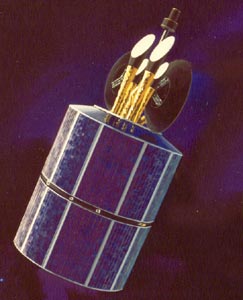Thank you very much for visiting Gunter's Space Page. I hope that this site is useful and informative for you.
If you appreciate the information provided on this site, please consider supporting my work by making a simple and secure donation via PayPal. Please help to run the website and keep everything free of charge. Thank you very much.
Intelsat-4

Intelsat-4 [Boeing BSS]
The Intelsat IV series of communications satellites, launched from Cape Canaveral during the early 1970's, marked the fifth generation of geostationary communications satellites developed by Hughes Aircraft Company since the 1963 launching of Syncom II, the world's first synchronous satellite. Syncom II, 15 inches high and 28 inches in diameter, weighed 78 pounds in orbit. In contrast, the Intelsat IVs weighed over 1300 pounds (595 kg) in orbit and were more than 17 feet (5.31 meters) in diameter. Launch vehicles for the satellites were the Atlas-Centaur rockets. Eight flight spacecraft and one prototype were built for the International Telecommunications Satellite Organization (INTELSAT). Communications Satellite Corporation (COMSAT) managed the Intelsat IV program for the then 109-nation organization. Seven of the huge satellites were successfully launched between January 1971 and May 1975.
Companies from 10 nations representing Europe, Japan, and Canada participated with Hughes in building the satellites.
Each Intelsat IV satellite could relay 6000 two-way telephone calls or transmit 12 simultaneous color television programs or varied combinations of communications traffic, including data and facsimile.
The communications subsystem consisted of global receive and both global and spot beam transmit antennas connected to a microwave 12-channel repeater that provided high power amplification for each channel. Six antennas -- two global receive, two global transmit, and two spot beam transmit -- were provided.
The spot beam feed horns illuminated the parabolic reflectors, which focused and redirected the energy toward earth. Each spot beam antenna was individually steerable, and its beam center could be pointed anywhere over the visible portion of the earth in incremental steps of less than 0.01 degrees.
The satellite had 12 broadband communications channels. Each channel had a bandwidth of 40 MHz and provided about 500 communications circuits. Four of the repeaters were dedicated to earth coverage antennas, and eight could be switched to either earth coverage or spot beam transmit antennas. All seven spacecraft exceeded their design lives and have been retired from active service, the last of which, Intelsat IV F-1 was retired in October 1987.
| Nation: | International |
|---|---|
| Type / Application: | Communication |
| Operator: | Intelsat |
| Contractors: | Hughes |
| Equipment: | 12 C-band transponders |
| Configuration: | HS-312 |
| Propulsion: | SVM-4A |
| Power: | Solar cells (body mounted), batteries |
| Lifetime: | |
| Mass: | 1414 kg (launch); 730 kg (BOL) |
| Orbit: | GEO |
| Satellite | COSPAR | Date | LS | Launch Vehicle | Remarks | |
|---|---|---|---|---|---|---|
| Intelsat-4 1 | 1975-042A | 22.05.1975 | CC LC-36A | Atlas-SLV3D Centaur-D1A | ||
| Intelsat-4 2 | 1971-006A | 26.01.1971 | CC LC-36A | Atlas-SLV3C Centaur-D | ||
| Intelsat-4 3 | 1971-116A | 20.12.1971 | CC LC-36A | Atlas-SLV3C Centaur-D | ||
| Intelsat-4 4 | 1972-003A | 23.01.1972 | CC LC-36B | Atlas-SLV3C Centaur-D | ||
| Intelsat-4 5 | 1972-041A | 13.06.1972 | CC LC-36B | Atlas-SLV3C Centaur-D | ||
| Intelsat-4 6 | 1975-F01 | 20.02.1975 | CC LC-36A | F | Atlas-SLV3D Centaur-D1A | |
| Intelsat-4 7 | 1973-058A | 23.08.1973 | CC LC-36A | Atlas-SLV3D Centaur-D1A | ||
| Intelsat-4 8 | 1974-093A | 21.11.1974 | CC LC-36B | Atlas-SLV3D Centaur-D1A |
References:
- Boeing: Intelsat IV
- Intelsat-1 1 [HS-303]
- Intelsat-2 1, 2, 3, 4 [HS-303A]
- Intelsat-3 1, 2, 3, 4, 5, 6, 7, 8
- Intelsat-4 1, 2, 3, 4, 5, 6, 7, 8 [HS-312]
- Intelsat-4A 1, 2, 3, 4, 5, 6 [HS-353]
- Intelsat-5 1, 2, 3, 4, 5, 6, 7, 8, 9
- Intelsat-5A 10, 11, 12, 13, 14, 15
- Intelsat-6 1, 2, 3, 4, 5 [HS-389]
- Intelsat-7 1, 2, 3, 4, 5, 9 [SSL-1300]
- Intelsat-7A 6, 7, 8 [SSL-1300]
- Intelsat-8 1, 2, 3, 4 [AS-7000]
- Intelsat-8A 5, 6 [AS-7000]
- Intelsat-9 1, 2, 3, 4, 5, 6, 7 [SSL-1300HL]
- Intelsat 10-01 [Eurostar-3000]
- Intelsat 10-02 [Eurostar-3000]
- Intelsat Americas 5, 6, 7 [SSL-1300]
- Intelsat Americas 8 [SSL-1300S]
- Intelsat Americas 9 [SSL-1300]
- Intelsat Americas 13 [SSL-1300]
- Intelsat-APR 1 [Spacebus-3000A]
- Intelsat-APR 2 [I-3K]
- Intelsat-APR 3 [Eurostar-2000+]
- Intelsat K [AS-5000]
- Intelsat K-TV [Eurostar-2000+]
- Intelsat 1R [HS-702]
- Intelsat 1W [Spacebus-4000B2]
- Intelsat 2, 3R, 4 [HS-601]
- Intelsat 5 [HS-601HP]
- Intelsat 6B [HS-601HP]
- Intelsat 7 [SSL-1300]
- Intelsat 8 [SSL-1300]
- Intelsat 9, 10 [HS-601HP]
- Intelsat 11 [Star-2]
- Intelsat 12 [SSL-1300]
- Intelsat 14 [SSL-1300]
- Intelsat 15 [Star-2]
- Intelsat 16 [Star-2]
- Intelsat 17 [SSL-1300]
- Intelsat 18 [Star-2]
- Intelsat 19 [SSL-1300]
- Intelsat 20 [SSL-1300]
- Intelsat 21 [BSS-702MP]
- Intelsat 22 [BSS-702MP]
- Intelsat 23 [Star-2]
- Intelsat 24 [AMOS-Bus]
- Intelsat 25 [SSL-1300]
- Intelsat 26 [HS-601]
- Intelsat 27 [BSS-702MP]
- Intelsat 28 [Star-2]
- Intelsat 29e [BSS-702MP]
- Intelsat 30, 31 [SSL-1300]
- Intelsat 32e [Eurostar-3000]
- Intelsat 33e [BSS-702MP]
- Intelsat 34 [SSL-1300]
- Intelsat 35e [BSS-702MP]
- Intelsat 36 [SSL-1300]
- Intelsat 37e [BSS-702MP]
- Intelsat 38 [SSL-1300]
- Intelsat 39 [SSL-1300]
- Intelsat 40e [SSL-1300]
- Intelsat 41, 44 [Space-Inspire]
- Intelsat 42, 43 [OneSat]
- Intelsat 45 [HummingSat]
- Intelsat 46 [Spacebus-Neo-200]
- New Dawn [Star-2]
